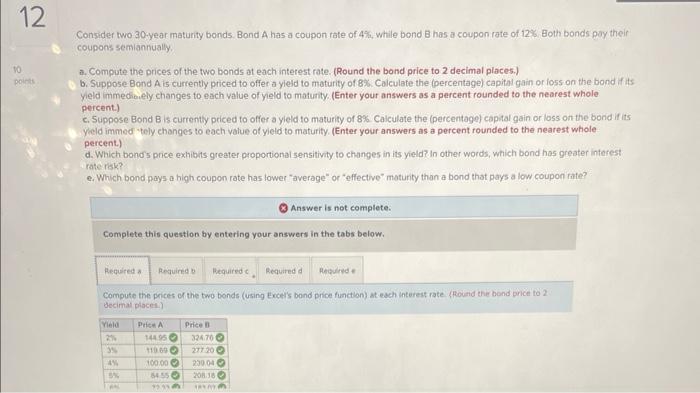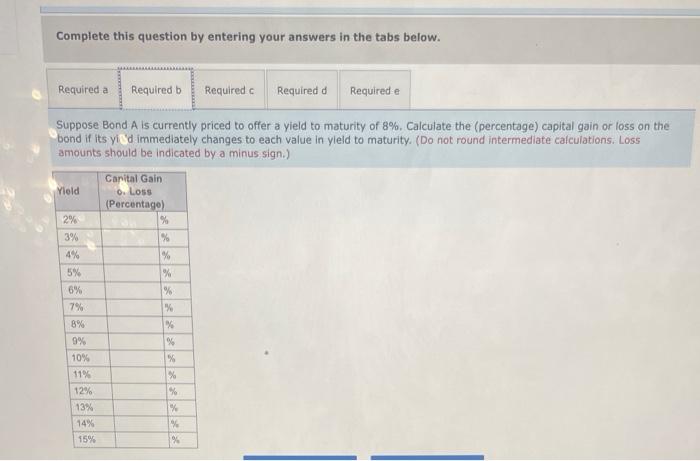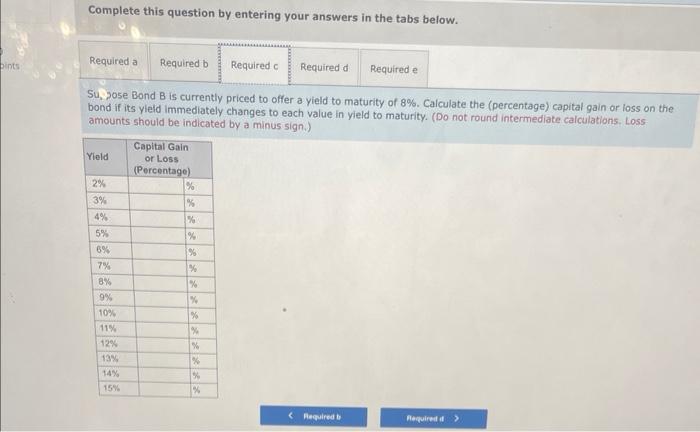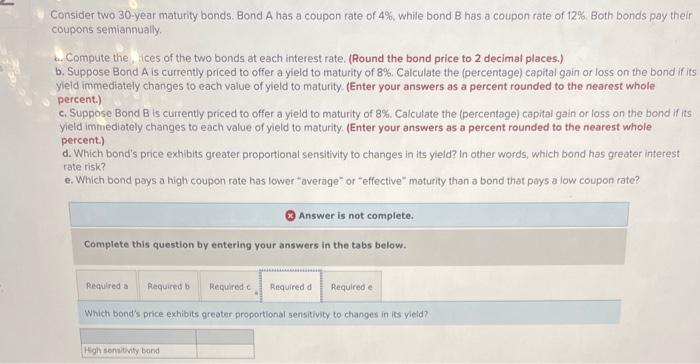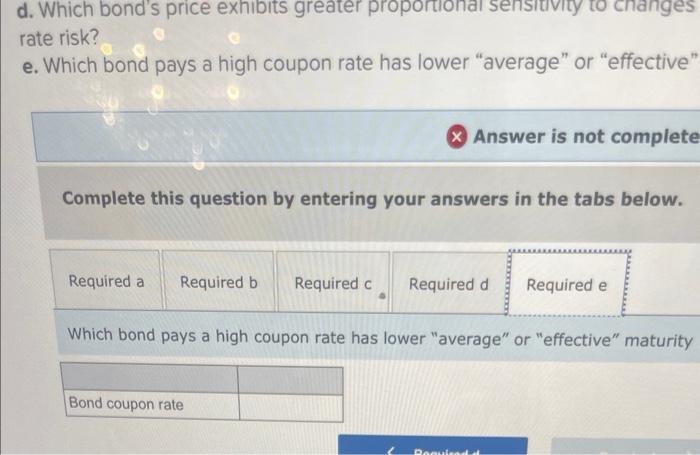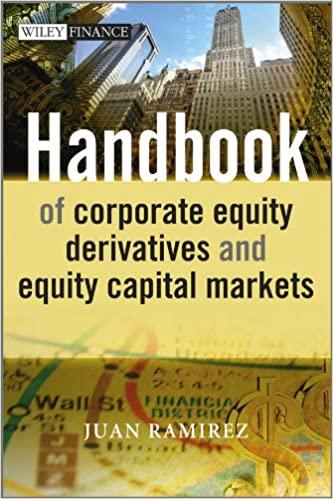12 10 points Consider two 30-year maturity bonds. Bond A has a coupon rate of 4%, while bond B has a coupon rate of 12%. Both bonds pay their coupons semiannually. a. Compute the prices of the two bonds at each interest rate. (Round the bond price to 2 decimal places.) b. Suppose Bond A is currently priced to offer a yield to maturity of 8%. Calculate the (percentage) capital gain or loss on the bond if its yield immedia.ely changes to each value of yield to maturity. (Enter your answers as a percent rounded to the nearest whole percent.) c. Suppose Bond B is currently priced to offer a yield to maturity of 8% Calculate the (percentage) capital gain or loss on the bond if its yield immed tely changes to each value of yield to maturity. (Enter your answers as a percent rounded to the nearest whole percent.) d. Which bond's price exhibits greater proportional sensitivity to changes in its yield? In other words, which bond has greater interest rate risk? e. Which bond pays a high coupon rate has lower "average" or "effective maturity than a bond that pays a low coupon rate? Answer is not complete. Complete this question by entering your answers in the tabs below. Required a Required c Required d Required e Compute the prices of the two bonds (using Excel's bond price function) at each interest rate (Round the bond price to 2- decimal places) Yield 2% 3% 4% 5% AN Required b Price A 144.95 119.60 100.00 84.55 22.11 Price B 324.70 277 20 230.04 208.18 133 Complete this question by entering your answers in the tabs below. Required a Required b Suppose Bond A is currently priced to offer a yield to maturity of 8%. Calculate the (percentage) capital gain or loss on the bond if its yi d immediately changes to each value in yield to maturity. (Do not round intermediate calculations. Loss amounts should be indicated by a minus sign.) Yield 2% 3% 4% 5% 6% 7% 8% 9% 10% 11% 12% 13% 14% 15% Carital Gain o. Loss (Percentage) % % % % % % % % % % % % Required c Required d Required e % pints Complete this question by entering your answers in the tabs below. Required b Required c Required d Required e Su, pose Bond B is currently priced to offer a yield to maturity of 8%. Calculate the (percentage) capital gain or loss on the bond if its yield immediately changes to each value in yield to maturity. (Do not round intermediate calculations. Loss amounts should be indicated by a minus sign.) Required a Yield 2% 3% 4% 5% 6% 7% 8% 9% 10% 11% 12% 13% 14% 15% Capital Gain or Loss (Percentage) % % % % % % % % % % % % % % Consider two 30-year maturity bonds. Bond A has a coupon rate of 4%, while bond B has a coupon rate of 12%. Both bonds pay their coupons semiannually. Compute the rices of the two bonds at each interest rate. (Round the bond price to 2 decimal places.) b. Suppose Bond A is currently priced to offer a yield to maturity of 8%. Calculate the (percentage) capital gain or loss on the bond if its yield immediately changes to each value of yield to maturity. (Enter your answers as a percent rounded to the nearest whole percent.) c. Suppose Bond B is currently priced to offer a yield to maturity of 8%. Calculate the (percentage) capital gain or loss on the bond if its yield immediately changes to each value of yield to maturity. (Enter your answers as a percent rounded to the nearest whole percent.) d. Which bond's price exhibits greater proportional sensitivity to changes in its yield? In other words, which bond has greater interest rate risk? e. Which bond pays a high coupon rate has lower "average" or "effective maturity than a bond that pays a low coupon rate? Answer is not complete. Complete this question by entering your answers in the tabs below. Required a Required b Required c Required d Required e Which bond's price exhibits greater proportional sensitivity to changes in its yield? High sensitivity bond d. Which bond's price exhibits greater proportional sensitivity to changes rate risk? e. Which bond pays a high coupon rate has lower "average" or "effective" Complete this question by entering your answers in the tabs below. Required a Required b Required c Answer is not complete Bond coupon rate Required d Which bond pays a high coupon rate has lower "average" or "effective" maturity quisa Required e
